How to extract Zip files on your computer
Compressed files are often unusable until you unzip them from the ZIP folder. Remember that ZIP folders are different from other compressed file types (for example, RAR files) in that they do not require special software to open on the computer.
Today's article will show you how to extract Zip files on Windows, Mac and Linux computers.
How to extract Zip files on your computer
- Unzip the .zip file in Windows
- Unzip the .zip file in Linux
- Unzip by GUI
- Unzip the file with the command line
- Preview the contents of the Zip file on the command line
- Selectively extract parts of Zip files
- Unzip the .zip file in UNIX
- Zip
- Tar
- Gunzip
- Unzip the .zip file on a Mac
Unzip the .zip file in Windows
Windows supports decompressing .zip files without installing any other tools. To extract the .zip file in Windows, do the following:
- Save the downloaded .zip file to your hard drive.
- Right click on the file and select " Extract all ". This will open the extract wizard.
- Click "Browse" and choose the location to extract the files if you don't want to save the file in the default location that Windows chooses. (Usually the directory containing the original compressed file)
- Select the " Make a new folder " option to create a new folder if needed.
- Select Show extracted files when complete to display the file after extracting or removing if you want.
- Click "Extract" to start the extraction process.
When the file decompression finishes, if you have selected Show extracted . then the folder containing the extracted file will be displayed for you to start working with the files.
Unzip the .zip file in Linux
Zip files were very popular before, when the download speed was slow and every byte saved was important. However, Zip is a popular file type. Sooner or later you will have to open a .zip file.
Depending on the distribution you are using, extracting a Zip archive can be very easy. However, it is also helpful to know some more advanced ways to open and process .zip files.
Unzip by GUI
On most Linux desktop environments, extracting a file is easy. Just right-click on the file and you'll see a few options. You can choose 'Extract Here' or 'Unzip Here' here.
You will also see the 'Extract To' option to extract to a specific location. This option is useful if you are trying to extract a file from the Downloads folder to another location. Not all desktop environments have these tools installed, but if they are, this is the simplest method.

If your desktop does not include these handy shortcuts, you can only open the .zip file in the GUI archive program. This program includes Gnome Archive Manager on the Gnome, Ark desktop on KDE desktop, etc.
If there is no GUI storage utility available or looking for more powerful features, select the command line.
Unzip the file with the command line
Some Linux command line utilities have complicated names, but that is not the case. The command to extract a file on Linux is simply called unzip.
The easiest way to extract a file on the Linux command line is to run the following command:
unzip filename.zip 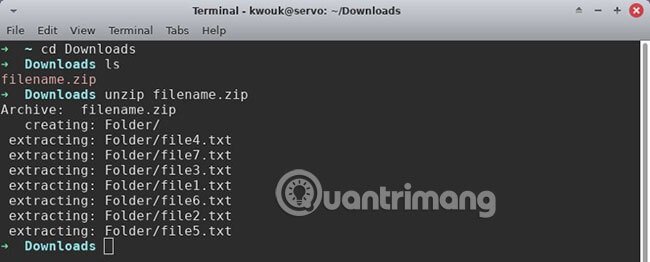
This command will extract the file directly in the directory in which it is located. If you want to extract in another folder, you can also do that. Imagine that you have a file in the download folder, want to extract in the home directory. To do this, run the following command.
unzip filename.zip -d ~/ Preview the contents of the Zip file on the command line
On the desktop, you can often double-click the Zip file to view its contents before extracting. However, it is not possible to do so on the command line.
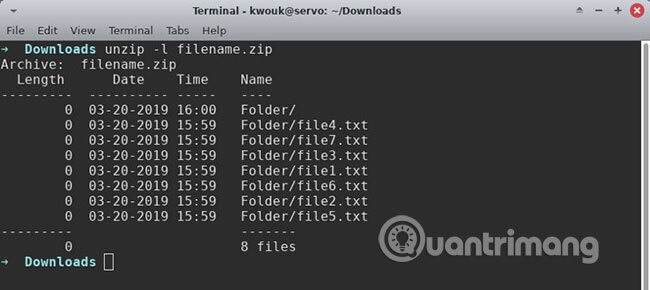
That doesn't mean you can't preview the contents of the Zip file. To do this, run the following command:
unzip -l filename.zip The content of the file will display in one line at a time.
Selectively extract parts of Zip files
Now you know how to preview the contents of the Zip file. You may realize that you don't need everything in that file. In this situation, you can handle two different ways: Extract one or two files from the Zip archive or select an unnecessary file to exclude from the extraction process.
To extract a single file from the Zip archive, you will need to provide the full path. This means that if there is a folder named Folder that contains everything, you will need to specify the full path to that directory.
unzip filename.zip "Folder/file1.txt" 
If you want to extract the file without creating a new directory, use the -j parameter :
unzip -j filename.zip "Folder/file1.txt" The way to exclude a file from the build process is similar, but use the -x parameter . If you want to exclude the file 'file.txt', run the following command:
unzip filename.zip -x "Folder/file1.txt" 
Unzip the .zip file in UNIX
There are several Zip file compression and decompression methods in UNIX. You should use the "zip" function to compress your files so that it is easy to use and portable. (Compressed files in Unix can be extracted with different tools on different platforms including Windows).
Here are the various "decompression" methods. The 'correct' decompression method depends on the method used to compress the file. You can tell how to compress the file through the file extension (eg .zip, .tar, .gz, etc.)
Please note that the decompression method you use is determined by the file name you are trying to extract. For example, if you are trying to extract a file called file.tar - you will use the method described in 'tar'. Files ending in .gzip or .gz should be extracted using the method described in 'gunzip'.
Zip
If you have a zip file called myzip.zip and want to extract the files, you will enter:
unzip myzip.zip
Entering zip or unzip will give you a summary of the usage, displaying almost all available options.
Tar
To extract a file that is compressed with tar (for example, filename.tar), type the following command from your SSH prompt:
tar xvf filename.tar
Basically, this command means you will see the file 'boom', so don't worry when you see your screen scrolling violently. It also means that you will see any errors in the compressed file.
Gunzip
To extract a file compressed with gunzip, enter the following:
gunzip filename_tar.gz
Then if you don't notice any errors, enter:
tar xvf filename_tar
Unzip the .zip file on a Mac
If you have purchased digital media that contains many files, you will download a .zip file containing the entire package. After the download is complete, you will find it in your default download location. If you are not sure where your default download directory is, proceed with the test.
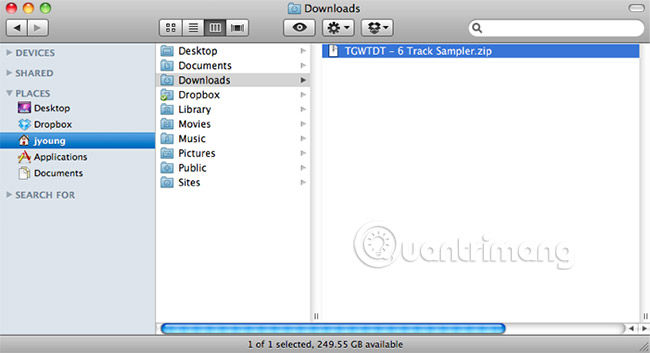
Before you add files to the media player library, you must first "extract" the files. If you double-click the .zip package that you downloaded, Archive Utility will appear and automatically extract your files. If double clicking doesn't work, please try the following:
1. Right-click the .zip package, and select Open With> Archive Utility (default).
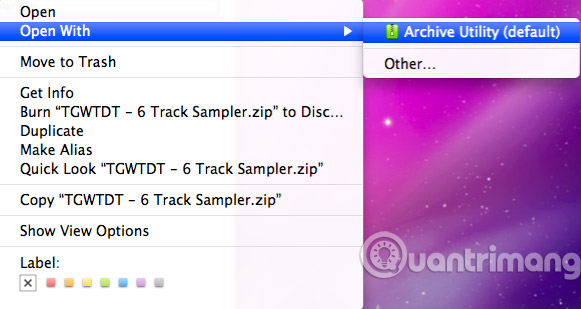
2. Archive Utility will appear on your screen and will display the extraction process.

3. When the files are extracted, they will appear in a folder located in the same location as the original .zip file.
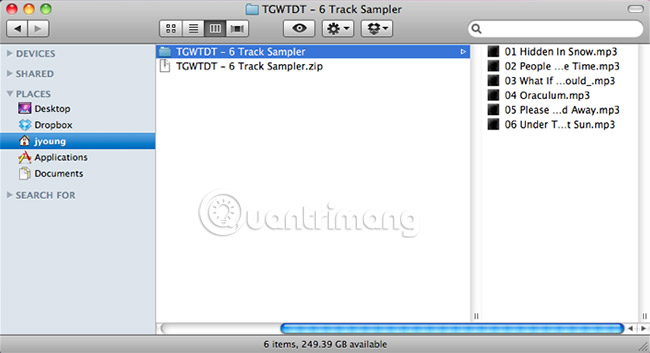
Now you can open your media file by adding the extracted files to the media player you choose.
See more:
- Unzip Zip, RAR, . files online without software
- How to extract Zip files on your computer
- The best RAR file extraction application on Android
You should read it
- 3 Simple way to extract ISO file
- How to extract a file or folder from a TAR or TAR.GZ file
- Instructions to change DMG file to ISO file
- How to extract ZIP file on computer quickly
- How to Extract a JAR File
- What is RAR file?
- The best RAR file extraction application on Android
- How to extract ISO file with Linux
May be interested
- How to extract multiple files on Windows 10
 application zip open zip all zip tar unrar unzip will extract multiple files simultaneously on windows 10.
application zip open zip all zip tar unrar unzip will extract multiple files simultaneously on windows 10. - How to open and extract ISO files with Winrar
 how to open and extract iso files with winrar. some of you don't know that the familiar winrar file compression and decompression software can also open and extract iso files easily.
how to open and extract iso files with winrar. some of you don't know that the familiar winrar file compression and decompression software can also open and extract iso files easily. - How to Open Zip Files
 today's tipsmake will show you how to open and extract a zip folder on your computer, smartphone or tablet. zip folders are used to compress files into lighter versions to facilitate storage and transmission. to view and use files in a zip folder in the proper format, you need to extract (or 'unzip') the zip folder into a regular folder.
today's tipsmake will show you how to open and extract a zip folder on your computer, smartphone or tablet. zip folders are used to compress files into lighter versions to facilitate storage and transmission. to view and use files in a zip folder in the proper format, you need to extract (or 'unzip') the zip folder into a regular folder. - How to extract ZIP file on computer quickly
 how to extract zip file on computer quickly. if you regularly download the data files on the internet to your computer, it is probably no stranger to the zip file format. this is a very common file compression format, compressing the file will ensure t
how to extract zip file on computer quickly. if you regularly download the data files on the internet to your computer, it is probably no stranger to the zip file format. this is a very common file compression format, compressing the file will ensure t - How to quickly extract .tar.gz file on Windows 10
 typically, tar files are commonly used by ubuntu and macos users for data storage and backup, but sometimes windows 10 users may encounter these types of files and need to extract its contents.
typically, tar files are commonly used by ubuntu and macos users for data storage and backup, but sometimes windows 10 users may encounter these types of files and need to extract its contents. - Instructions to use Onekey Ghost to create and extract Ghost files quickly
 using computers to create ghost files and extract ghost files is very common when we need to install windows or move windows. currently, there are many tools to support users to create ghost files and extract ghost files quickly.
using computers to create ghost files and extract ghost files is very common when we need to install windows or move windows. currently, there are many tools to support users to create ghost files and extract ghost files quickly. - 3 Simple way to extract ISO file
 3 simple way to extract iso file. iso files are a popular file format, especially for large files such as windows, office installers, or heavy game installation files. extracting iso file is quite simple, if you do not know how
3 simple way to extract iso file. iso files are a popular file format, especially for large files such as windows, office installers, or heavy game installation files. extracting iso file is quite simple, if you do not know how - Helps you decompress RAR and ZIP files on iPhone quickly
 there are many apple users who want to find a way to extract rar and zip files on iphone phones. don't worry because tipsmake will reveal it right away
there are many apple users who want to find a way to extract rar and zip files on iphone phones. don't worry because tipsmake will reveal it right away - Steps to Extract PDF Document Pages on Mac with Preview tool
 sometimes you just need to refer to a specific page in a pdf document with dozens of states. in such situations, the preview application on mac can help you easily extract a specific page from any pdf document file.
sometimes you just need to refer to a specific page in a pdf document with dozens of states. in such situations, the preview application on mac can help you easily extract a specific page from any pdf document file. - How to Open RAR Files
 this wikihow teaches you how to extract and open a rar file. rar files are actually folders that contain multiple files that have been compressed to save space. with the help of some free software, you can extract and open rar files on...
this wikihow teaches you how to extract and open a rar file. rar files are actually folders that contain multiple files that have been compressed to save space. with the help of some free software, you can extract and open rar files on...










 How to automatically delete files after compression on WinRAR
How to automatically delete files after compression on WinRAR 3 ways to compress and decompress files in Chromebook
3 ways to compress and decompress files in Chromebook How do video compression algorithms work?
How do video compression algorithms work? How to create shopping lists with Google Assistant
How to create shopping lists with Google Assistant 8 easy steps to create portable software with WinRAR
8 easy steps to create portable software with WinRAR Winrar and features you may not know yet
Winrar and features you may not know yet